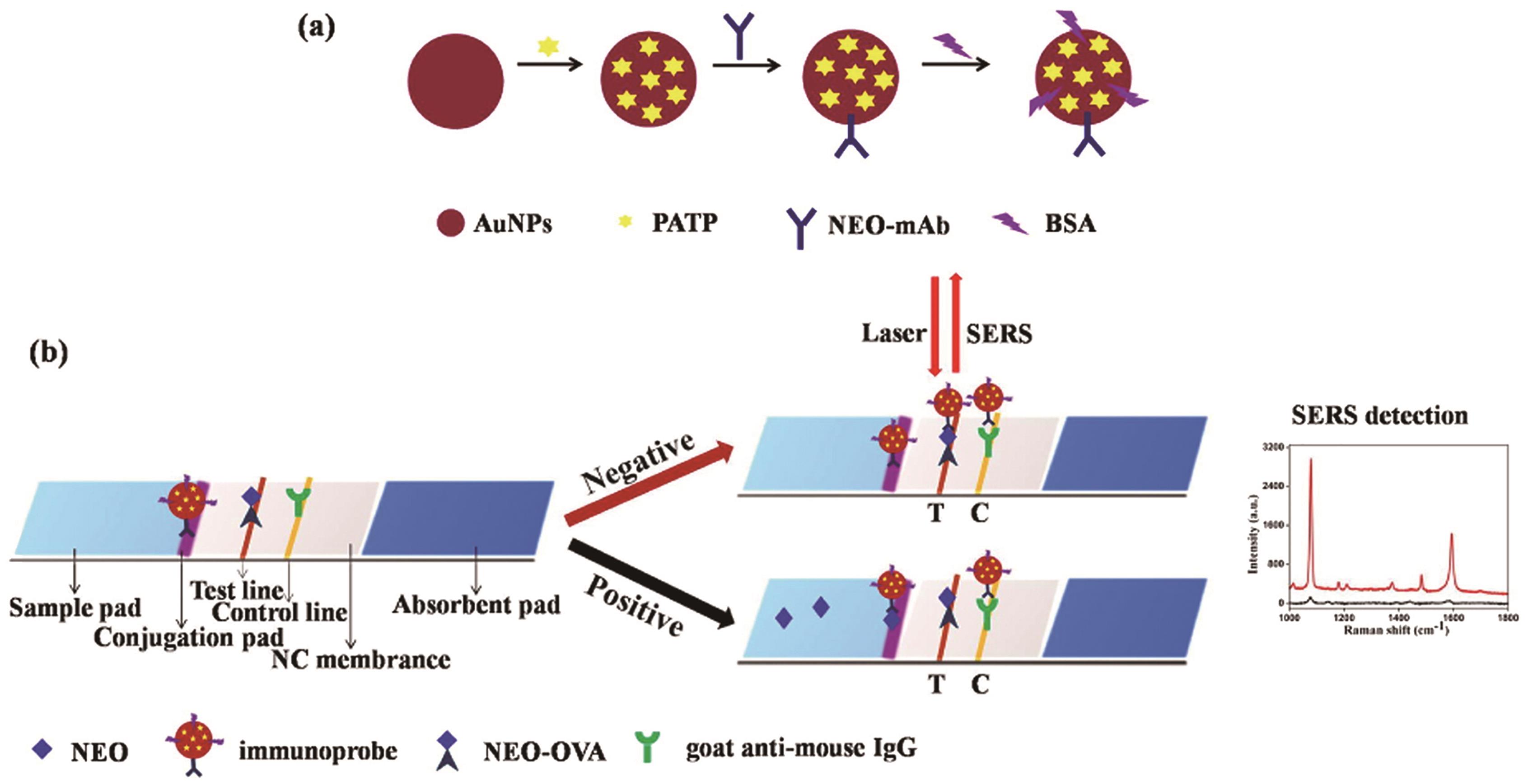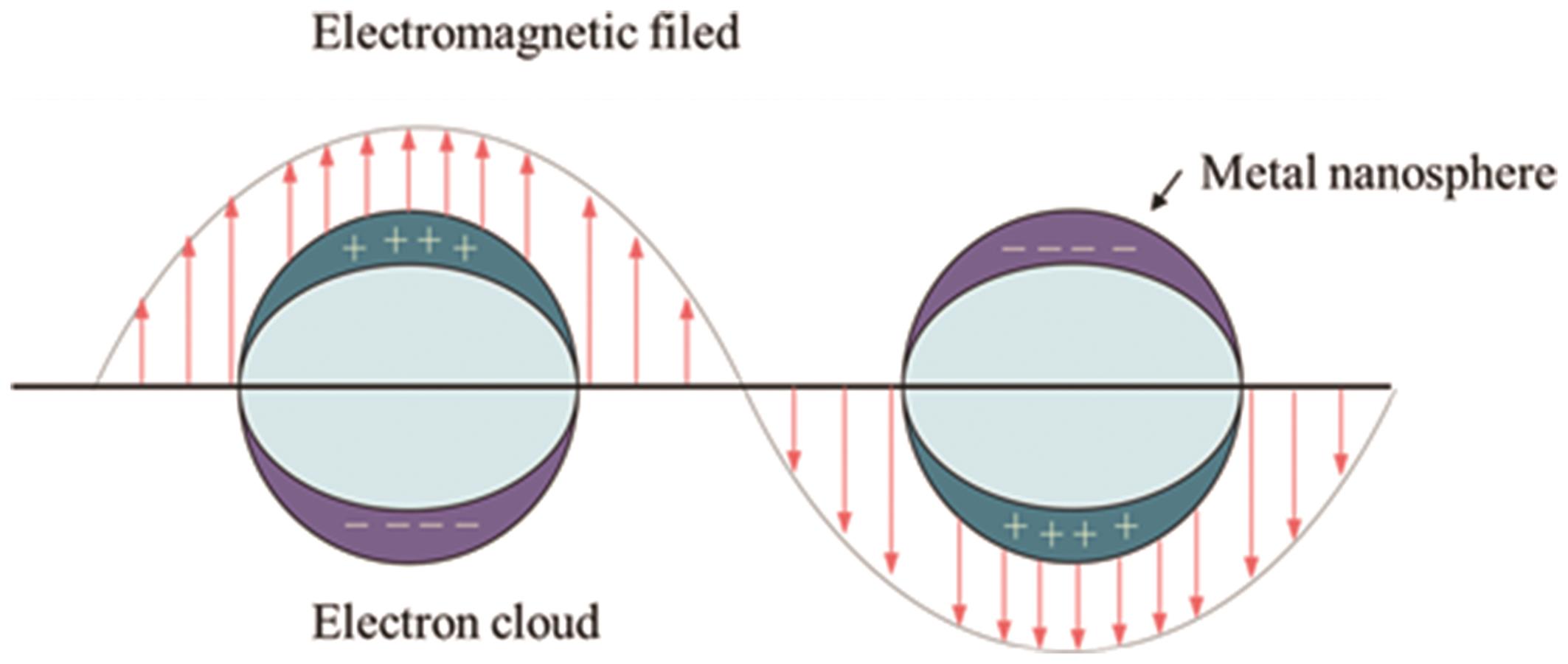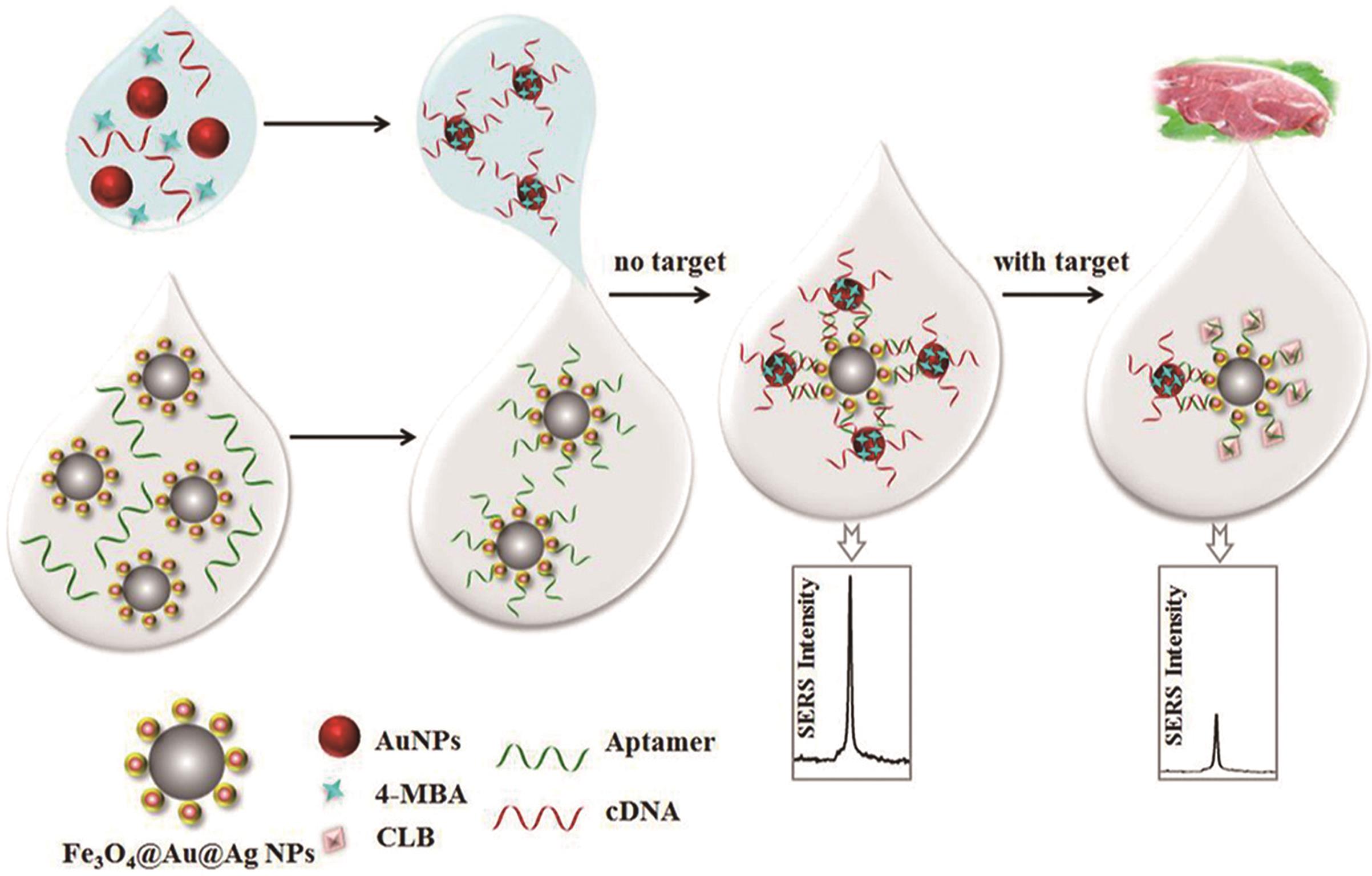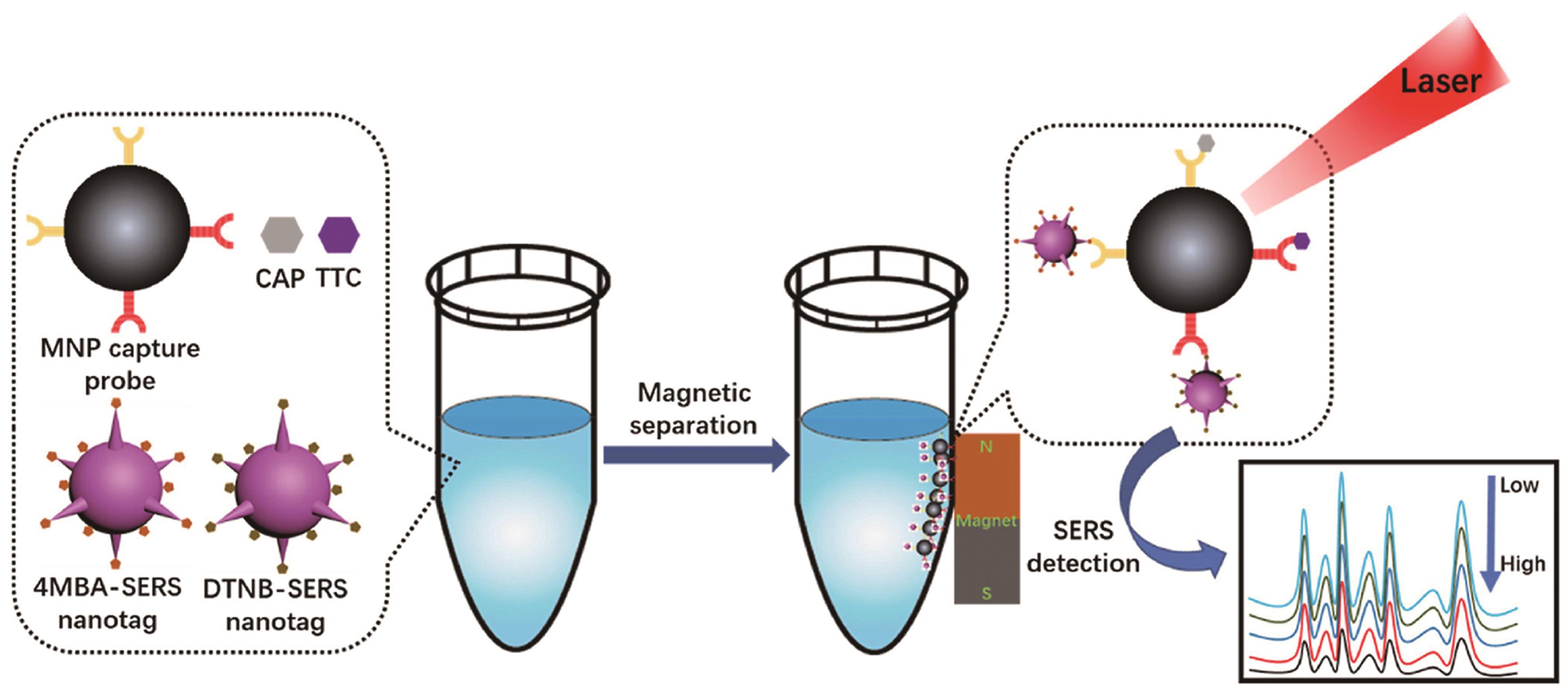
Chinese Journal of Applied Chemistry ›› 2024, Vol. 41 ›› Issue (4): 459-471.DOI: 10.19894/j.issn.1000-0518.230251
• Review •
Advances in Surface-Enhanced Raman Spectroscopy for the Detection of Veterinary Drug Residues in Foods of Animal Origin
Jia-Huan PEI1, Xiao-Hua QI2, Ming-Qiang ZOU2, Yong JIN2, De-Ying WANG1, Yun-Jing LUO1( )
)
- 1.Faculty of Environment and Life,Beijing University of Technology,Beijing 100124,China
2.Chinese Academy of Inspection and Quarantine,Beijing 116023,China
-
Received:2023-08-22Accepted:2024-02-01Published:2024-04-01Online:2024-04-28 -
Contact:Yun-Jing LUO -
About author:luoyj@bjut.edu.cn
-
Supported by:the National Key Research and Development Program(2022YFF0607903);the Basic Research Operating Costs of the Academy of Inspection and Quarantine(2022JK18);the Key Research and Development Program of Hainan Province(SQ2021SHFZ0721)
CLC Number:
Cite this article
Jia-Huan PEI, Xiao-Hua QI, Ming-Qiang ZOU, Yong JIN, De-Ying WANG, Yun-Jing LUO. Advances in Surface-Enhanced Raman Spectroscopy for the Detection of Veterinary Drug Residues in Foods of Animal Origin[J]. Chinese Journal of Applied Chemistry, 2024, 41(4): 459-471.
share this article
Add to citation manager EndNote|Ris|BibTeX
URL: http://yyhx.ciac.jl.cn/EN/10.19894/j.issn.1000-0518.230251

Fig.4 SERS combined with immunochromatography for NEO detection. (a) Schematic illustration showing preparation of immunoprobe; (b) Assembly of the LFI strip and the schematic diagram of the SERS-LFI strip for NEO detection[54]
| Veterinary drug | Brochure | Cogeneration technology | SERS substrate | Ref. |
|---|---|---|---|---|
| Clenbuterol hydrochloride | Pork | Aptamer recognition | Fe3O4@Au@Ag | [ |
| Pork, Beef and Lamb | Lateral flow immunochromatography(LFI) | Fe3O4@Au | [ | |
| Pig Urine | Magnetic beads for immunisation | GO/AuNPs | [ | |
| Ractopamine | Milk | Immunological analyses | AuNPs | [ |
| Chloramphenicol | Milk | Immunological analyses | AuNS@Ag | [ |
| Tetracycline | ||||
| Benzylpenicillin sodium | Milk | — | AgNPs | [ |
| Sulfamethazine | Water or Milk | Surface impregnation | MIP@AgNPs | [ |
Table 1 Application of SERS technology to meat, milk and other foods of animal origin
| Veterinary drug | Brochure | Cogeneration technology | SERS substrate | Ref. |
|---|---|---|---|---|
| Clenbuterol hydrochloride | Pork | Aptamer recognition | Fe3O4@Au@Ag | [ |
| Pork, Beef and Lamb | Lateral flow immunochromatography(LFI) | Fe3O4@Au | [ | |
| Pig Urine | Magnetic beads for immunisation | GO/AuNPs | [ | |
| Ractopamine | Milk | Immunological analyses | AuNPs | [ |
| Chloramphenicol | Milk | Immunological analyses | AuNS@Ag | [ |
| Tetracycline | ||||
| Benzylpenicillin sodium | Milk | — | AgNPs | [ |
| Sulfamethazine | Water or Milk | Surface impregnation | MIP@AgNPs | [ |
| 1 | LI H P, WU J Y, LI A F, et al. Immunochromatographic assay for the detection of antibiotics in animal-derived foods: a review[J]. Food Control, 2021, 130: 108356. |
| 2 | 赵琼, 刘学明. 动物源性食品中抗生素残留的快速检测方法研究[J]. 现代食品, 2022, 28(2): 75-77. |
| ZHAO Q, LIU X M. Study on the rapid detection method of antibiotic residues in animal-derived foods[J]. Modern Food, 2022, 28(2): 75-77. | |
| 3 | 中华人民共和国秦皇岛出入境检验检疫局. 常用兽药残留量检测方法标准选编[M]. 北京: 中国标准出版社, 2009: 53. |
| Qinhuangdao Entry-Exit Inspection and Quarantine Bureau. People's Republic of China. Selection of Common Veterinary Drug residue detection methods[M]. Beijing: Standards Press of China, 2009: 53. | |
| 4 | RAMIN B, RICHARD P, AMOR A. Rapid detection of amitriptyline in dried blood and dried saliva samples with surface-enhanced raman spectroscopy[J]. Sensors, 2022, 22(21): 8257. |
| 5 | 高天宇. 显微拉曼光谱仪的研制及其在矿物谱学研究中的应用[D]. 兰州: 兰州大学, 2022. |
| GAO T Y. Development of microRaman spectrometer and its application in mineral spectroscopy research[D].Lanzhou: Lanzhou University, 2022. | |
| 6 | MING X. A review on applications of two-dimensional materials in surface-enhanced raman spectroscopy[J]. Int J Spectrosc, 2018: 20181-20189. |
| 7 | AWADA C. Plasmonic enhanced SERS in Ag/TiO2 nanostructured film: an experimental and theoretical study[J]. Micromachines, 2022, 13(10): 1595. |
| 8 | HEEG S, MUELLER N S, WASSERROTH S, et al. Experimental tests of surface-enhanced Raman scattering: moving beyond the electromagnetic enhancement theory[J]. J Raman Spectrosc, 2021, 52(2): 310-322. |
| 9 | VALLEY N, JENSEN L, AUTSCHBACH J, et al. Theoretical studies of surface enhanced hyper-Raman spectroscopy: the chemical enhancement mechanism[J]. J Chem Phys, 2010, 133(5): 054103. |
| 10 | ABE H, MANZEL K, SCHULZE W, et al. Surface-enhanced Raman spectroscopy of CO adsorbed on colloidal silver particles[J]. J Chem Phys, 1981, 74(2): 792-797. |
| 11 | 丁松园, 吴德印, 杨志林, 等. 表面增强拉曼散射增强机理的部分研究进展[J]. 高等学校化学学报, 2008, 29(12): 2569-2581. |
| DING S Y, WU D Y, YANG Z L, et al. Some progresses in mechanistic studies on surface-enhanced Raman scattering[J]. Chem J Chin Univ, 2008, 29(12): 2569-2581. | |
| 12 | ZHANG X, ZOU M, QI X, et al. Detection of melamine in liquid milk using surface-enhanced Raman scattering spectroscopy[J]. J Raman Spectrosc, 2010, 41(12): 1655-1660. |
| 13 | 赵佳, 闫景辉, 齐小花, 等. 贵金属核壳纳米材料的制备及其SERS应用[C]//中国光学学会, 中国化学会. 第十七届全国分子光谱学学术会议论文集. 北京大学出版社, 2012: 2. |
| ZHAO J, YAN J H, QI X H, et al. Preparation of noble metal core-shell nanomaterials and their SERS applications[C]//Optical Society of China, Chinese Chemical Society. Proceedings of the 17th National Conference on Molecular Spectroscopy. Peking University Press, 2012: 2. | |
| 14 | 张璐涛, 周光明, 罗丹, 等. 表面增强拉曼光谱快速检测蜂蜜中的金霉素残留[J]. 高等学校化学学报, 2018, 39(8): 1662-1667. |
| ZHANG L T, ZHOU G M, LUO D, et al. Rapid detection on chlortetracycline residues in honey by surface-enhanced Raman spectroscopy[J]. Chem J Chin Univ, 2018, 39(8): 1662-1667. | |
| 15 | 李春颖, 王红义, 李永春, 等. 表面增强拉曼光谱技术在动物源性食品兽药残留检测中的应用[J]. 光谱学与光谱分析, 2023, 43(6): 1667-1675. |
| LI C Y, WANG H Y, LI Y C, et al. Application of surface-enhanced Raman spectroscopy in detection of veterinary drug residues in food of animal origin[J]. Spectro Spectral Anal, 2019, 43(6): 1667-1675. | |
| 16 | STAMBACH N R, CARR S A, COX C R, et al. Rapid detection of Listeria by bacteriophage amplification and SERS-lateral flow immunochromatography[J]. Viruses, 2015, 7(12): 6631-6641. |
| 17 | YAO K, XIE X, JIAO J, et al. Plasmonic cellulose microfilament assisted SERS detection in microfluidics[J]. Spectrochim Acta Part A: Mole Biomol Spectrosc, 2024, 308: 123631. |
| 18 | YUE L,ZHIYU Q,AIHUI L, et al.A new N/Fe doped carbon dot nanosurface molecularly imprinted polymethacrylate nanoprobe for trace fipronil with SERS/RRS dimode technique[J]. Talanta, 2023: 269125417. |
| 19 | MARKINA N E, MARKIN A V, ZAKHAREVICH A M, et al. Calcium carbonate microparticles with embedded silver and magnetite nanoparticles as new SERS-active sorbent forsolid phase extraction[J]. Microchim Acta, 2017, 184(10): 3937-3944. |
| 20 | 路晓琦, 刘子健, 喻倩, 等. 基于茚三酮衍生化TLC-SERS检测血清中的多巴胺[J]. 光谱学与光谱分析, 2023, 43(S1): 251-252. |
| LU X Q, LIU Z J, YU Q, et al. Detection of dopamine in serum by TLC-SERS derived from ninhydrin[J]. Spectro Spectral Anal, 2023, 43(S1): 251-252. | |
| 21 | ZENG B, HUANG Y, FAN M. Interference free HPLC-SERS for the trace analysis of residual furazolidones in the aquaculture sediment[J]. Chemosensors, 2022, 10(12): 508. |
| 22 | BANIUKEVIC J, BOYACI I H, BOZURT A G, et al. Magnetic gold nanoparticles in SERS-based sandwich immunoassay for antigen detection by well oriented antibodies[J]. Biosens Bioelectron, 2013, 43: 281-288. |
| 23 | TABB J S, RAPOPORT E, HAN I, et al. An antigen-targeting assay for Lyme disease: combining aptamers and SERS to detect the OspA protein[J]. Nanomedicine, 2022, 41: 102528. |
| 24 | SHAO D, BI S, ZHAO R, et al. Selective determination of dinitolmide and toltrazuril by surface-enhanced raman spectroscopy (SERS) using AgNPs as substrate[J]. Sens Actuators B: Chem, 2020, 307: 127644. |
| 25 | CHEN J, HUANG M, KONG L. Flexible Ag/nanocellulose fibers SERS substrate and its applications for in-situ hazardous residues detection on food[J]. Appl Surf Sci, 2020, 533: 147454. |
| 26 | MA M, SUN J, CHEN Y, et al. Highly sensitive SERS immunosensor for the detection of amantadine in chicken based on flower-like gold nanoparticles and magnetic bead separation[J]. Food Chem Toxicol, 2018, 118: 589-594. |
| 27 | LIANG D, XU Y, PENG F, et al. Plasmonic metal NP-bismuth composite film with amplified SERS activity for multiple detection of pesticides and veterinary drugs[J]. Chem Eng J, 2023, 474: 145933. |
| 28 | 刘世娟. HPLC-MS/MS检测肌肉组织中多头孢菌素残留方法的建立[D]. 合肥: 安徽农业大学, 2012. |
| LIU S J. Establishment on HPLC-MS/MS detection methods for multi-cephalosporins in muscle tissues[D]. Hefei: Anhui Agricultural University, 2012. | |
| 29 | 王志恒, 刘松雁, 宋瑞, 等. 畜产品中兽药残留前处理技术研究进展[J]. 中国畜牧兽医文摘, 2017, 33(11): 20-21. |
| WANG H Z, LIU S Y, SONG R, et al. Research progress of pretreatment technology of veterinary drug residues in animal products [J]. Chin Abstr Anim Vet Med, 2017, 33(11): 20-21. | |
| 30 | 季宝成, 杨澜瑞, 韩雨, 等. 动物源性食品兽药多残留检测中基质净化与液相色谱-质谱联用技术研究进展[J/OL]. 轻工学报: 1-9[2023-07-05]. |
| JI B C, YANG L R, HAN Y, et al. Research progress of matrix purification and liquid chromatography-mass spectrometry in multiresidue detection of animal derived food and veterinary drugs[J/OL]. J Light Ind: 1-9[2023-07-05]. | |
| 31 | FARAJZADEH M A, ABBASPOUR M. Development of new extraction method based on liquid-liquid-liquid extraction followed by dispersive liquid-liquid microextraction for extraction of three tricyclic antidepressants in plasma samples[J]. Biomed Chromatogr, 2018, 32(8): e4251. |
| 32 | 曹晨, 赵超敏, 张润何, 等. 基于检出概率模型的牛奶中恩诺沙星和环丙沙星总量的拉曼光谱现场快速检测的研究[J]. 中国食品卫生杂志, 2023, 35(3): 326-332. |
| CAO C, ZHAO C M, ZHANG R H, et al. Rapid detection of enrofloxacin and ciprofloxacin in milk by Raman spectroscopy based ondetection probability model[J]. Chin J Food Hyg, 2023, 35(3): 326-332. | |
| 33 | 施思倩, 杨方威, 姚卫蓉, 等. 表面增强拉曼光谱法快速检测猪肉中左旋咪唑残留[J]. 光谱学与光谱分析, 2021, 41(12): 3759-3764. |
| SHI S Q, YANG F W, YAO W R, et al. Rapid detection of levamisole residues in pork by surface enhanced Raman spectroscopy[J]. Spectro Spectral Anal, 2021, 41(12): 3759-3764. | |
| 34 | 尹林华, 肖小华, 霍冰洋, 等. 化妆品分析样品前处理方法的研究进展[J]. 分析测试学报, 2023, 42(5): 647-656. |
| YIN L H, XIAO X H, HUO B Y, et al. Research progress in sample pretreatment methods for cosmetic samples analysis[J]. J Instrum Anal, 2023, 42(5): 647-656. | |
| 35 | 中国兽药典委员会.兽药质量标准: 化学药品卷[M]. 2017年版. 北京: 中国农业出版社, 2017. |
| Chinese Veterinary Pharmacopoeia Committee. Quality Standards for Veterinary Drugs: Chemicals Volume[M]. 2017 edition. Beijing: China Agric Press, 2017. | |
| 36 | JIN M, SHAN J, WANG X, et al. Determination of florfenicol in antibiotic mixtures by solid-phase extraction (SPE) and surface-enhanced raman scattering (SERS)[J]. Anal Lett, 2022, 55(4): 517-528. |
| 37 | YUROVA N S, MARKINA N E, POZHAROV M V, et al. SERS-active sorbent based on aluminum oxide loaded with silver nanoparticles[J]. Colloids Surf A, 2016, 495: 169-175. |
| 38 | XIANGYI K, ZHUANG L, ENHUA F, et al. Determination of nine N-nitrosamines in animal derived foods by QuEChERS-isotope dilution combined with gas chromatography-tandem mass spectrometry[J]. Chin J Chromatogr, 2021, 39(1): 96. |
| 39 | 黄胜广, 赵卉, 王玉方, 等. 畜产品中兽药残留检测方法的研究进展[J]. 特产研究, 2020, 42(2): 65-75. |
| HUANG S G, ZHAO H, WANG Y F, et al. Research progress in detection methods of veterinary drug residuesin animal products[J]. Spec Wild Econ Anim Plant Res, 2020, 42(2): 65-75. | |
| 40 | LIU S H, WEN B Y, LIN J S, et al. Rapid and quantitative detection of aflatoxin B 1 in grain by portable Raman spectrometer[J]. Appl Spectrosc, 2020, 74(11): 1365-1373. |
| 41 | 邱富娜. 食品中兽药残留的种类及检测技术[J]. 中国畜牧业, 2022(4): 52 -53. |
| QIU F N. Types and detection techniques of veterinary drug residues in food [J]. China Anim Ind, 2022(4): 52-53. | |
| 42 | ZHAI F, HUANG Y, WANG X, et al. Surface-enhanced Raman spectroscopy for rapid determination of β-agonists in swine urine[J]. Chin J Anal Chem, 2012, 40(5): 718-723. |
| 43 | 张蕾, 冯腾垒, 曹楠, 等. 动物源性食品中β-受体激动剂残留检测技术研究进展[J]. 今日畜牧兽医, 2021, 37(7): 1. |
| ZHANG L, FENG T L, CAO N, et al. Research progress of detection technology of β-agonist residues in food of animal origin [J]. Today Anim Husb Vet Med, 2021, 37(7): 1. | |
| 44 | KYUNG I S, JUNG S P, KYUTAE K, et al. Development and application of a method for rapid and simultaneous determination of three β-agonists (clenbuterol, ractopamine, and zilpaterol) using liquid chromatography-tandem mass spectrometry[J]. Korean J Food Sci Anim Resour, 2015, 35(1): 121-129. |
| 45 | DUAN N, QI S, GUO Y, et al. Fe3O4@Au@Ag nanoparticles as surface-enhanced Raman spectroscopy substrates for sensitive detection of clenbuterol hydrochloride in pork with the use of aptamer binding[J]. LWT, 2020, 134: 110017. |
| 46 | WU T, LI J, ZHENG S, et al. Magnetic nanotag-based colorimetric/SERS dual-readout immunochromatography for ultrasensitive detection of clenbuterol hydrochloride and ractopamine in food samples[J]. Biosensors, 2022, 12(9): 709. |
| 47 | CHENG J, SU X O, WANG S, et al. Highly sensitive detection of clenbuterol in animal urine using immunomagnetic bead treatment and surface-enhanced Raman spectroscopy[J]. Sci Rep, 2016, 6(1): 32637. |
| 48 | YU M, HU Y, LIU J. Simultaneous detection of clenbuterol and ractopamine based on multiplexed competitive surface enhanced Raman scattering (SERS) immunoassay[J]. New J Chem, 2017, 41(18): 10407-10414. |
| 49 | ZHAI F, HUANG Y, LI C, et al. Rapid determination of ractopamine in swine urine using surface-enhanced Raman spectroscopy[J]. J Agric Food Chem, 2011, 59(18): 10023-10027. |
| 50 | BRANDT K K, AMEZQUITA A, BACKHAUS T, et al. Ecotoxicological assessment of antibiotics: a call for improved consideration of microorganisms[J]. Environ Int, 2015, 85: 189-205. |
| 51 | LIU X, STEELE J C, MENG X Z. Usage, residue, and human health risk of antibiotics in Chinese aquaculture: a review[J]. Environ Pollut, 2017, 223: 161-169. |
| 52 | WANG M, PENG B, ZHAO N, et al. Multiresidue analysis of tetracycline and β-receptor agonists in chicken by pressurized liquid extraction and liquid chromatography-tandem mass spectrometry: comparison with QuEChERS extraction method and ultrasound assisted extraction[J]. J Food Compos Anal, 2020, 85: 103339. |
| 53 | LIU B, ZHENG S, LI H, et al. Ultrasensitive and facile detection of multiple trace antibiotics with magnetic nanoparticles and core-shell nanostar SERS nanotags[J]. Talanta, 2022, 237: 122955. |
| 54 | SHI Q, HUANG J, SUN Y, et al. Utilization of a lateral flow colloidal gold immunoassay strip based on surface-enhanced Raman spectroscopy for ultrasensitive detection of antibiotics in milk[J]. Spectrochim Acta Part A, 2018, 197: 107-113. |
| 55 | 祖玉梅. β-内酰胺类抗生素的应用与发展现状[J]. 中国实用医药, 2010, 5(30): 246-248. |
| ZU Y M. Application and development status of β-lactam antibiotics[J]. China Pract Med, 2010, 5(30): 246-248. | |
| 56 | 刘里, 董建伟, 杨蒋美. 氨苄青霉素测定方法的研究进展[J]. 山东化工, 2022, 51(15): 74-82. |
| LIU L, DONG J W, YANG J M. Advances in the determination of ampicillin[J]. Shandong Chem Ind, 2022, 51(15): 74-82. | |
| 57 | JIANG X, QIN X, YIN D, et al. Rapid monitoring of benzylpenicillin sodium using Raman and surface enhanced Raman spectroscopy[J]. Spectrochim Acta Part A, 2015, 140: 474-478. |
| 58 | 梁营芳, 周化岚, 张建国, 等. 表面增强拉曼光谱法测定牛奶中青霉素G钠的残留量[J]. 理化检验-化学分册, 2022, 58(3): 285-290. |
| LIANG Y F, ZHOU H L, ZHANG J G, et al. Determination of penicillin G sodium residue in milk by surface-enhanced Raman spectroscopy[J]. Phys Test Chem Anal Part B Mater Test, 2022, 58(3): 285-290. | |
| 59 | VAN BAMBEKE F, MICHOT J M, VAN E J, et al. Quinolones in 2005: an update[J]. Clin Microbiol Infect, 2005, 11(4): 256-280. |
| 60 | 李琳, 文学忠, 钟雯, 等. 检测氟喹诺酮类药物残留方法对比与分析[J]. 农业与技术, 2015, 35(21): 7-9. |
| LI L, WEN XZ, ZHONG W, et al. Comparison and analysis of methods for detection of fluoroquinolone residues[J]. Agric Technol, 2015, 35(21): 7-9. | |
| 61 | 闫帅, 李永玉, 彭彦昆, 等. 表面增强拉曼光谱结合化学计量学快速检测鸡蛋中的喹诺酮类抗生素残留[J]. 分析化学, 2022, 50(10): 1578-1586. |
| YAN S, LI Y Y, PENG Y K, et al. Rapid detection of quinolone antibiotic residues in eggs by surface-enhanced Raman spectroscopy combined with chemometrics[J]. Chin J Anal Chem, 2022, 50(10): 1578-1586. | |
| 62 | HE L, LIN M, LI H, et al. Surface-enhanced Raman spectroscopy coupled with dendritic silver nanosubstrate for detection of restricted antibiotics[J]. J Raman Spectrosc, 2010, 41(7): 739-744. |
| 63 | WANG W, SANG Q, YANG M, et al. Detection of several quinolone antibiotic residues in water based on Ag-TiO2 SERS strategy[J]. Sci Total Environ, 2020, 702: 134956. |
| 64 | WANG S, ZHANG H, WANG L, et al. Analysis of sulphonamide residues in edible animal products: a review[J]. Food Addit Contam, 2006, 23(4): 362-384. |
| 65 | 白丽丽, 戴华, 林正峰. 高效液相色谱-串联质谱法检测虾中9种磺胺类药物的残留[J]. 中国当代医药, 2011, 18(23): 60-61. |
| BAI L L, DAI H, LIN Z F. Simultaneous determination of 9 sulfonamides residues in shrimps by highperformance liquid chromatography-tandem mass spectrometry[J].China Mod Med, 2011, 18(23): 60-61. | |
| 66 | 刘琳. 表面增强拉曼光谱结合分子印迹技术的磺胺类抗生素识别研究[D]. 无锡:江南大学, 2022. |
| LIU L. Study on recognition of sulfonamides based onsurface enhanced Raman spectroscopy and molecular imprinting technique[D]. Wuxi: Jiangnan University, 2022. | |
| 67 | OUYANG L, ZHU L, RUAN Y, et al. Preparation of a native β-cyclodextrin modified plasmonic hydrogel substrate and its use as a surface-enhanced Raman scattering scaffold for antibiotics identification[J]. J Mater Chem C, 2015, 3(29): 7575-7582. |
| [1] | ZHANG Meng, CHEN Dong-Zhen, REN Yan-Wei, NING Pan. Sensing Interface Based on Nanoislandlike Sliver Film@Gold Nanotip for Surface Enhanced Raman Scattering Analysis of Dopamine [J]. Chinese Journal of Applied Chemistry, 2021, 38(7): 866-873. |
| [2] | ZHU Yuezhou,ZHANG Yuejiao,LI Jianfeng,REN Bin,TIAN Zhongqun. Surface-Enhanced Raman Spectroscopy: Applications and Perspectives [J]. Chinese Journal of Applied Chemistry, 2018, 35(9): 984-992. |
| [3] | YAN Zhaodong,LI Yang,ZHANG Tao,LIU Zhicheng,LIU Yaqing. Gold Nanorod-loaded Electrospun Fibers:Preparation and Surface-enhanced Raman Spectroscopy Performance [J]. Chinese Journal of Applied Chemistry, 2017, 34(5): 519-526. |
| [4] | WANG Haoran, YANG Weicheng, TU Yahui, YANG Chao, FANG Chao, LI Meihua, LUO Yong, WU Fanhong. Synthesis and Properties of Stable Isotope Deuterium Labeled D4-Rhodamine B [J]. Chinese Journal of Applied Chemistry, 2016, 33(8): 939-944. |
| Viewed | ||||||
|
Full text |
|
|||||
|
Abstract |
|
|||||


